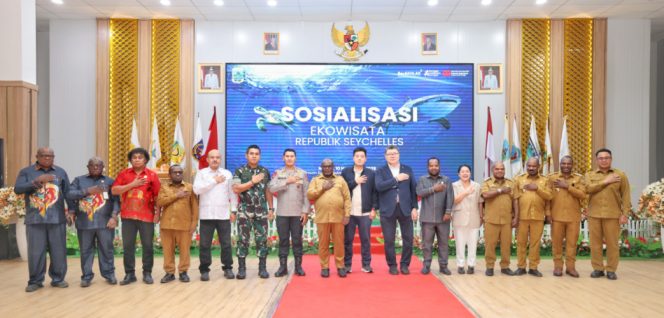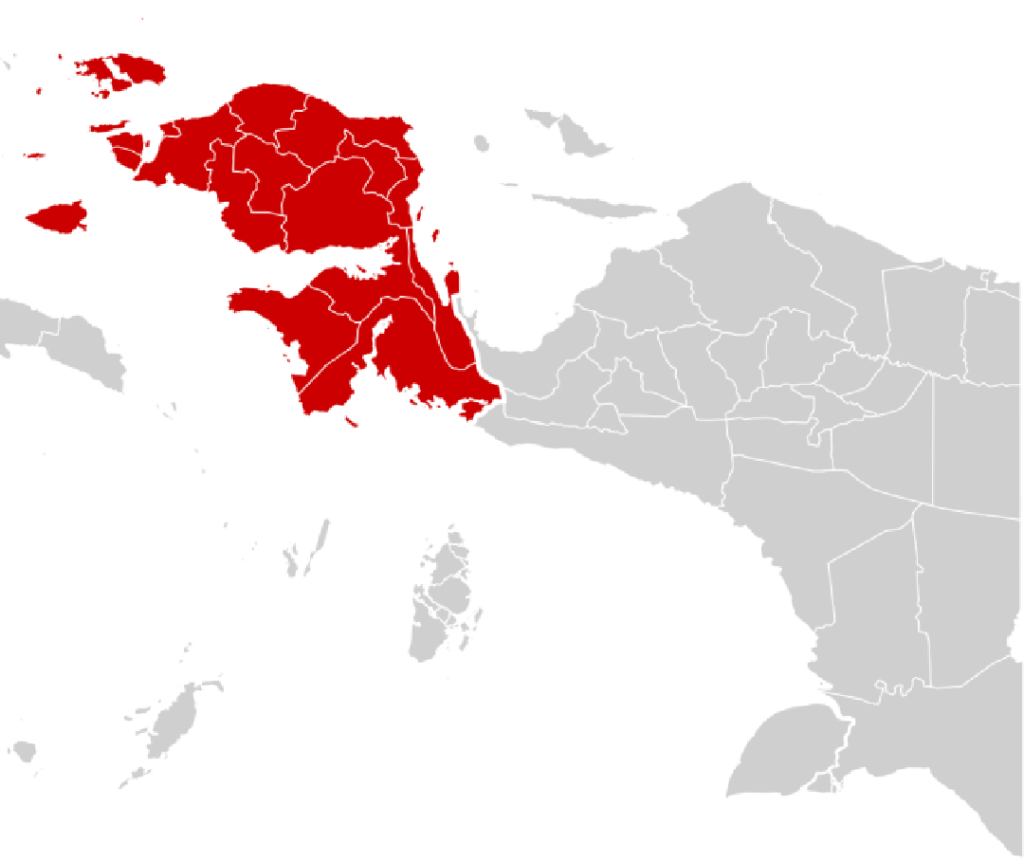Under the bright tropical sky of Nabire, Papua Tengah (Central Papua), a remarkable partnership began to take shape—one that bridges two distant island worlds. The Republic of Seychelles, known globally as a model for sustainable island tourism, has expressed its full commitment to support the development of the tourism sector in Papua Tengah, Indonesia.
The recent meeting between Seychelles Ambassador to Indonesia, Nico Barito, and Papua Tengah Governor Meki Nawipa, was more than a diplomatic courtesy call. It marked the start of a visionary collaboration between two regions that share similar geographies and dreams—lush biodiversity, vibrant marine ecosystems, and aspirations for economic growth through sustainable tourism.
As reported by Antara News, CNN Indonesia, and Tribun Papua Tengah, Seychelles’ involvement focuses on sharing best practices in ecotourism, local economy development, and environmental conservation, offering hope for a more globally connected and sustainable future for Papua Tengah.
Island to Island: The Vision Behind the Collaboration
Though separated by thousands of kilometers across the Indian Ocean, Seychelles and Papua share the same heart of tropical beauty. Both regions are home to stunning coastlines, coral reefs, and endemic species that attract the world’s curiosity. Yet, both also face the same challenge—how to develop tourism without compromising their fragile ecosystems and cultural heritage.
Seychelles, a small island nation off the coast of East Africa, is widely regarded as one of the world’s most successful examples of sustainable tourism. Despite being the smallest country in Africa, it has built a thriving economy by balancing environmental conservation with tourism growth.
According to Ambassador Nico Barito, Seychelles is eager to help Papua Tengah learn from its decades-long journey of developing eco-friendly tourism industries and integrating local communities into the heart of the economy. “Seychelles is ready to share its experience and expertise to ensure that Papua Tengah can grow sustainably,” Barito stated during his visit to Nabire, as quoted by Seputar Papua.
Governor Meki Nawipa welcomed this gesture with deep appreciation, highlighting that the partnership could transform Papua Tengah’s untapped natural beauty into a global tourism magnet while empowering local communities.
The Meeting in Nabire: Laying the Groundwork for Cooperation
The historic meeting took place in Nabire, the administrative heart of Papua Tengah Province, on November 10, 2025. It was attended by provincial government officials, local tourism stakeholders, and representatives from Seychelles’ diplomatic mission in Jakarta.
During the dialogue, Ambassador Barito emphasized that Seychelles’ model of community-based and conservation-driven tourism could be adapted to Papua Tengah’s unique context. The collaboration would involve technical knowledge-sharing, training, and potentially, the introduction of investment cooperation in infrastructure, hospitality, and marine conservation projects.
As reported by Papua Bangkit and Merdeka.com, Barito also shared the success story of Seychelles’ Blue Economy—a development approach that integrates ocean-based industries such as fisheries, tourism, and renewable energy while maintaining environmental integrity. He suggested that Papua Tengah could follow a similar path by developing its coastal and island tourism around Nabire, Dogiyai, and Paniai.
Governor Nawipa, in response, expressed his enthusiasm:
“We are honored by Seychelles’ willingness to share their knowledge. Papua Tengah has extraordinary tourism potential—from coral reefs and mountain lakes to indigenous cultural experiences—but we must ensure that development benefits our people and preserves our environment.”
This statement reflected the province’s commitment to sustainability as a core principle, not an afterthought.
Learning from Seychelles: A Model for Sustainable Tourism
For Seychelles, sustainability is not just a policy—it is the foundation of its national identity. Over the years, the island nation has turned its limited land area and fragile ecosystems into a competitive advantage through environmental stewardship and smart policy-making.
Ambassador Barito explained that Seychelles’ tourism model could serve as an inspirational roadmap for Papua Tengah. The country allocates large areas of its land and marine territory as protected conservation zones, ensuring that tourism revenues directly support environmental protection.
He also encouraged the Papuan government to strengthen community-based tourism initiatives that involve indigenous people as hosts, guides, and entrepreneurs—not just as passive beneficiaries. This approach, he said, is essential to ensuring local ownership and pride in tourism development.
“Tourism is not only about building hotels or bringing visitors,” Barito said, as reported by Papua Tengah TribunNews. “It is about building the capacity of local people to tell their own stories, to welcome the world, and to protect what makes their home special.”
Such an approach resonates strongly in Papua Tengah, where local identity and ecological balance are deeply intertwined. Many traditional Papuan communities have long practiced conservation values through customary laws known as sasi, which regulate the use of natural resources. Seychelles’ model could reinforce these indigenous systems with modern management and international exposure.
Unlocking Papua Tengah’s Hidden Gems
Papua Tengah is one of Indonesia’s youngest provinces, carved out of the former Papua Province in 2022. Despite being new administratively, it is home to some of the most breathtaking natural wonders in the archipelago. From the turquoise waters of Teluk Cenderawasih (Cenderawasih Bay)—known for its gentle whale sharks—to the serene highland lakes of Paniai and Dogiyai, the region offers a diverse landscape that remains largely untouched by mass tourism.
Governor Nawipa highlighted that Seychelles’ expertise would be invaluable in mapping priority areas for tourism development, building sustainable infrastructure, and promoting Papua Tengah as an ecotourism destination. The government aims to attract both domestic and international visitors through niche experiences such as diving, birdwatching, cultural immersion, and adventure travel.
In collaboration with the Ministry of Tourism and Creative Economy, Papua Tengah is also planning to develop community homestay networks and eco-resorts designed with environmental and cultural sensitivity. Seychelles’ involvement, Nawipa said, would ensure that these projects are guided by best practices rather than profit-driven exploitation.
The cooperation also aligns with President Prabowo Subianto’s national vision to promote equitable development across Indonesia, emphasizing that the outermost and easternmost provinces must not be left behind in the country’s tourism growth story.
Beyond Tourism: Building the Blue Economy Together
Both Seychelles and Papua Tengah recognize that their strength lies in the sea. The cooperation plan therefore extends beyond tourism—toward the development of a sustainable Blue Economy.
Ambassador Barito pointed out that in Seychelles, marine-based industries contribute significantly to national income, not through overexploitation but through responsible governance and innovation. He encouraged Papua Tengah to adopt similar strategies, emphasizing marine biodiversity research, renewable ocean energy, and sustainable fisheries.
He also proposed academic exchanges and training programs between Seychelles and Indonesian universities to build local expertise in marine ecology and tourism management. “Capacity building is the most important investment,” he remarked, “because sustainable tourism begins with people who understand their environment.”
Governor Nawipa responded positively, stating that Papua Tengah was ready to embrace innovation while preserving its cultural and ecological roots. “We want our people to be skilled and proud of what they can offer to the world,” he said, according to Kabar Papua.
A Vision of Hope: Connecting Papua Tengah to the World
The Seychelles’ initiative arrives at a critical moment for Papua Tengah. The province is still in the early stages of economic development, and tourism is seen as a strategic pillar to diversify its economy away from dependence on extractive industries.
Through this collaboration, Papua Tengah can learn how to build an internationally competitive tourism sector while avoiding the pitfalls of uncontrolled mass tourism. Seychelles’ example offers reassurance that small regions, when guided by strong environmental ethics, can thrive on a global scale.
The partnership also represents a symbolic connection—one that unites two distant island communities under a shared vision of ecological harmony and cultural pride. As reported by Papua Antara, both sides plan to formalize their cooperation through a memorandum of understanding (MoU) in 2026, marking the beginning of long-term engagement.
For Papua Tengah, this is more than a partnership—it is a statement of confidence. A signal to the world that this young province is ready to open its doors to global collaboration while staying true to its identity.
Conclusion
The collaboration between Seychelles and Papua Tengah reflects a new era of international cooperation built not on size or power, but on shared values and mutual respect. It demonstrates that even the smallest nations can offer great lessons in resilience, sustainability, and leadership.
As Papua Tengah begins its journey to transform natural beauty into sustainable prosperity, the wisdom of Seychelles offers both guidance and inspiration. Together, these two island regions remind the world that tourism, when managed with care, can be more than an industry—it can be a bridge between cultures, a protector of nature, and a source of hope for generations to come.
In the words of Governor Meki Nawipa:
“Papua Tengah is ready to learn, to grow, and to shine—not only for Indonesia but for the world.”


